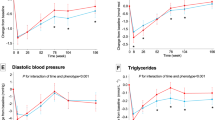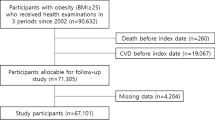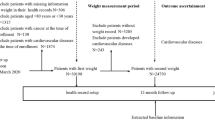Abstract
Background/Objectives:
The Sibutramine Cardiovascular OUTcomes (SCOUT) trial showed a significantly increased relative risk of nonfatal cardiovascular events, but not mortality, in overweight and obese subjects receiving long-term sibutramine treatment with diet and exercise. We examined the relationship between early changes (both increases and decreases) in body weight and blood pressure, and the impact of these changes on subsequent cardiovascular outcome events.
Subjects/Methods:
A total of 9804 male and female subjects, aged 55 years or older, with a body mass index of 27–45 kg m–2 were included in this current subanalysis of the SCOUT trial. Subjects were required to have a history of cardiovascular disease and/or type 2 diabetes mellitus with at least one cardiovascular risk factor (hypertension, dyslipidemia, current smoking or diabetic nephropathy) to assess cardiovascular outcomes. Post hoc subgroup analyses of weight change (categories) and blood pressure were performed overall and by treatment group (6-week sibutramine followed by randomized placebo or continued sibutramine). The primary outcome event (POE) was a composite of nonfatal myocardial infarction, nonfatal stroke, resuscitated cardiac arrest or cardiovascular death. Time-to-event analyses of the POE were performed using Cox regression models with factors for treatment, subgroups and interactions.
Results:
During the initial 6-week sibutramine treatment period, systolic blood pressure decreased progressively with increasing weight loss in hypertensive subjects (−8.1±10.5 mm Hg with <5 kg weight loss to −10.8±11.0 mm Hg with ⩾5 kg weight loss). The highest POE incidence occurred mainly in groups with increases in both weight and blood pressure. However, with long-term sibutramine treatment, a markedly lower blood pressure tended to increase POEs.
Conclusion:
Modest weight loss and modest lower blood pressure each reduced the incidence of cardiovascular events, as expected. However, the combination of early marked weight loss and rapid blood pressure reduction seems to be harmful in this obese elderly cardiovascular diseased population.
This is a preview of subscription content, access via your institution
Access options
Subscribe to this journal
Receive 12 print issues and online access
$259.00 per year
only $21.58 per issue
Buy this article
- Purchase on Springer Link
- Instant access to full article PDF
Prices may be subject to local taxes which are calculated during checkout


Similar content being viewed by others
References
Yusuf S, Hawken S, Ounpuu S, Bautista L, Franzosi MG, Commerford P et al. Obesity and the risk of myocardial infarction in 27 000 participants from 52 countries: a case-control study. Lancet 2005; 366: 1640–1649.
Lawes CMM, Hoorn SV, Elliott P, Rodgers A . Blood pressure and the burden of coronary heart disease. In: Marmot M, Elliott P (eds). Coronary Heart Disease Epidemiology: From Aetiology to Public Health, 2nd edn. Oxford University Press: Oxford, UK, 2005, pp 152–173.
Chobanian AV, Bakris GL, Black HR, Cushman WC, Green LA, Izzo JL Jr et al. The Seventh Report of the Joint National Committee on Prevention, Detection, Evaluation, and Treatment of High Blood Pressure: the JNC 7 report. JAMA 2003; 289: 2560–2572.
Graham I, Atar D, Borch-Johnsen K, Boysen G, Burell G, Cifkova R et al. European guidelines on cardiovascular disease prevention in clinical practice: executive summary: Fourth Joint Task Force of the European Society of Cardiology and Other Societies on Cardiovascular Disease Prevention in Clinical Practice (Constituted by representatives of nine societies and by invited experts). Eur Heart J 2007; 28: 2375–2414.
Snow V, Barry P, Fitterman N, Qaseem A, Weiss K . Pharmacologic and surgical management of obesity in primary care: a clinical practice guideline from the American College of Physicians. Ann Intern Med 2005; 142: 525–531.
Caterson ID, Finer N, Coutinho W, Van Gaal LF, Maggioni AP, Torp-Pedersen C et al. Maintained intentional weight loss reduces cardiovascular outcomes: results from the Sibutramine Cardiovascular OUTcomes (SCOUT) trial. Diabetes Obes Metab 2012; 14: 523–530.
Sjöström L, Narbro K, Sjöström CD, Karason K, Larsson B, Wedel H et al. Effects of bariatric surgery on mortality in Swedish obese subjects. N Engl J Med 2007; 357: 741–752.
Adams TD, Gress RE, Smith SC, Halverson RC, Simper SC, Rosamond WD et al. Long-term mortality after gastric bypass surgery. N Engl J Med 2007; 357: 753–761.
Lean M, Finer N . ABC of obesity. Management: part II—drugs. BMJ 2006; 333: 794–797.
Halford JC, Boyland EJ, Cooper SJ, Dovey TM, Huda MS, Dourish CT et al. The effects of sibutramine on the microstructure of eating behaviour and energy expenditure in obese women. J Psychopharmacol 2010; 24: 99–109.
Heusser K, Tank J, Diedrich A, Engeli S, Klaua S, Krüger N et al. Influence of sibutramine treatment on sympathetic vasomotor tone in obese subjects. Clin Pharmacol Ther 2006; 79: 500–508.
Lechin F, van der Dijs B, Hernandez G, Orozco B, Rodriguez S, Baez S . Neurochemical, neuroautonomic and neuropharmacological acute effects of sibutramine in healthy subjects. Neurotoxicology 2006; 27: 184–191.
James WP, Caterson ID, Coutinho W, Finer N, Van Gaal LF, Maggioni AP et al. Effect of sibutramine on cardiovascular outcomes in overweight and obese subjects. N Engl J Med 2010; 363: 905–917.
Torp-Pedersen C, Caterson I, Coutinho W, Finer N, Van Gaal L, Maggioni A et al. Cardiovascular responses to weight management and sibutramine in high-risk subjects: an analysis from the SCOUT trial. Eur Heart J 2007; 28: 2915–2923.
James WP . The SCOUT study: risk-benefit profile of sibutramine in overweight high-risk cardiovascular patients. Eur Heart J Suppl 2005; 7: L44–L48.
Sharma AM, Caterson ID, Coutinho W, Finer N, Van Gaal L, Maggioni AP et al. Blood pressure changes associated with sibutramine and weight management—an analysis from the 6-week lead-in period of the sibutramine cardiovascular outcomes trial (SCOUT). Diabetes Obes Metab 2009; 11: 239–250.
Stevens VJ, Obarzanek E, Cook NR, Lee IM, Appel LJ, Smith West D et al. Long-term weight loss and changes in blood pressure: results of the Trials of Hypertension Prevention, phase II. Ann Intern Med 2001; 134: 1–11.
Tuck ML, Sowers J, Dornfeld L, Kledzik G, Maxwell M . The effect of weight reduction on blood pressure, plasma renin activity, and plasma aldosterone levels in obese patients. N Engl J Med 1981; 304: 930–933.
Zhang W, Roederer MW, Chen WQ, Fan L, Zhou HH . Pharmacogenetics of drugs withdrawn from the market. Pharmacogenomics 2012; 13: 223–231.
Uretsky S, Messerli FH, Bangalore S, Champion A, Cooper-Dehoff RM, Zhou Q et al. Obesity paradox in patients with hypertension and coronary artery disease. Am J Medicine 2007; 120: 863–870.
Strandberg TE, Strandberg AY, Salomaa VV, Pitkälä KH, Tilvis RS, Sirola J et al. Explaining the obesity paradox: cardiovascular risk, weight change, and mortality during long-term follow-up in men. Eur Heart J 2009; 30: 1720–1727.
Angerås O, Albertsson P, Karason K, Råmunddal T, Matejka G, James S et al. Evidence for obesity paradox in patients with acute coronary syndromes: a report from the Swedish Coronary Angiography and Angioplasty Registry. Eur Heart J 2013; 34: 345–353.
Oreopoulos A, McAlister FA, Kalantar-Zadeh K, Padwal R, Ezekowitz JA, Sharma AM et al. The relationship between body mass index, treatment, and mortality in patients with established coronary artery disease: a report from APPROACH. Eur Heart J 2009; 30: 2584–2592.
Cushman WC, Evans GW, Byington RP, Goff DC Jr, Grimm RH Jr, Cutler JA et al. ACCORD Study Group Effects of intensive blood-pressure control in type 2 diabetes mellitus. N Engl J Med 2010; 362: 1575–1585.
Cooper-DeHoff RM, Gong Y, Handberg EM, Bavry AA, Denardo SJ, Bakris GL et al. Tight blood pressure control and cardiovascular outcomes among hypertensive patients with diabetes and coronary artery disease. JAMA 2010; 304: 61–68.
Cooper-DeHoff RM, Egelund EF, Pepine CJ . Blood pressure lowering in patients with diabetes—one level might not fit all. Nat Rev Cardiol 2011; 8: 42–49.
Birkenfeld AL, Schroeder C, Pischon T, Tank J, Luft FC, Sharma AM et al. Paradoxical effect of sibutramine on autonomic cardiovascular regulation in obese hypertensive patients—sibutramine and blood pressure. Clin Auto Res 2005; 15: 200–206.
Kannel WB, Wilson PW, Nam BH, D’Agostino RB, Li J . A likely explanation for the J-curve of blood pressure cardiovascular risk. Am J Cardiol 2004; 94: 380–384.
Messerli FH, Mancia G, Conti CR, Hewkin AC, Kupfer S, Champion A et al. Dogma disputed: can aggressively lowering blood pressure in hypertensive patients with coronary artery disease be dangerous? Ann Internal Med 2006; 144: 884–893.
Messerli FH, Panjrath GS . The J-curve between blood pressure and coronary artery disease or essential hypertension: exactly how essential? J Am Coll Cardiol 2009; 54: 1827–1834.
Acknowledgements
This work was supported and funded by Abbott Laboratories (Abbott Park, IL, USA). The Executive Steering Committee designed the study in co-operation with the Sponsor. The Sponsor obtained the data, which were assessed jointly by the authors and the Sponsor. The authors had full access to all data, determined the analyses, were responsible for its interpretation and wrote the manuscript. The final decision to submit the manuscript for publication was taken by the authors. The study was registered as a clinical trial on the Clinical Trial Registry, www.clinicaltrials.gov (Identifier: NCT00234832).
Author information
Authors and Affiliations
Corresponding author
Ethics declarations
Competing interests
NF: member of SCOUT ESC received payments from Abbott, as advisor for Novo Nordisk, Merck, sanofi-aventis, GlaxoSmithKline and Shionogi, consultant for Ajinomoto, and provided expert testimony for sanofi-aventis, Vivus, Arena and received a grant from GlaxoSmithKline. UFL was an employee of Abbott with equity interest in the Company. AMS is the member of the SCOUT ESC received payment from Abbott Laboratories, and is an advisor for Abbott, Merck, Arena, Novo-Nordisk, sanofi-aventis, GlaxoSmithKline, Boehringer Ingelheim and NeuroSearch, as a consultant for Vivus and Allegan, provided expert testimony for GlaxoSmithKline, received grants from Abbott and Covidian. WPTJ: Chair of the SCOUT ESC received payment from Abbott; the International Association for the Study of Obesity of which he is the President, he also received a grant from Novo Nordisk. WC is the member of the SCOUT ESC, received payments from Abbott Laboratories, lecture fees and/or travel reimbursement from Abbott, Ache Laboratorios Farmaceuticos S/A, Roche and Novo Nordisk, as an advisor for Abbott, Ache Laboratorios Farmaceuticos S/A, GSK, Novo Nordisk, Takeda and Roche, and provided expert testimony for Abbott. IDC is a member of SCOUT Executive Steering Committee (ESC) received payment from Abbott Laboratories, royalties from Wiley-Blackwell as co-editor of an obesity textbook, and the Boden Institute of Obesity, Nutrition and Exercise received grants from sanofi-aventis, Pfizer (Australia), Weight Watchers, Allergan and the Korean Ministry of Agriculture. The remaining authors declare no conflict of interest.
Rights and permissions
About this article
Cite this article
Seimon, R., Espinoza, D., Ivers, L. et al. Changes in body weight and blood pressure: paradoxical outcome events in overweight and obese subjects with cardiovascular disease. Int J Obes 38, 1165–1171 (2014). https://doi.org/10.1038/ijo.2014.2
Received:
Revised:
Accepted:
Published:
Issue Date:
DOI: https://doi.org/10.1038/ijo.2014.2
Keywords
This article is cited by
-
Anti-Inflammatory Effects of Melatonin in Obesity and Hypertension
Current Hypertension Reports (2018)
-
Changes in body weight and pulse: outcome events in overweight and obese subjects with cardiovascular disease in the SCOUT trial
International Journal of Obesity (2015)



